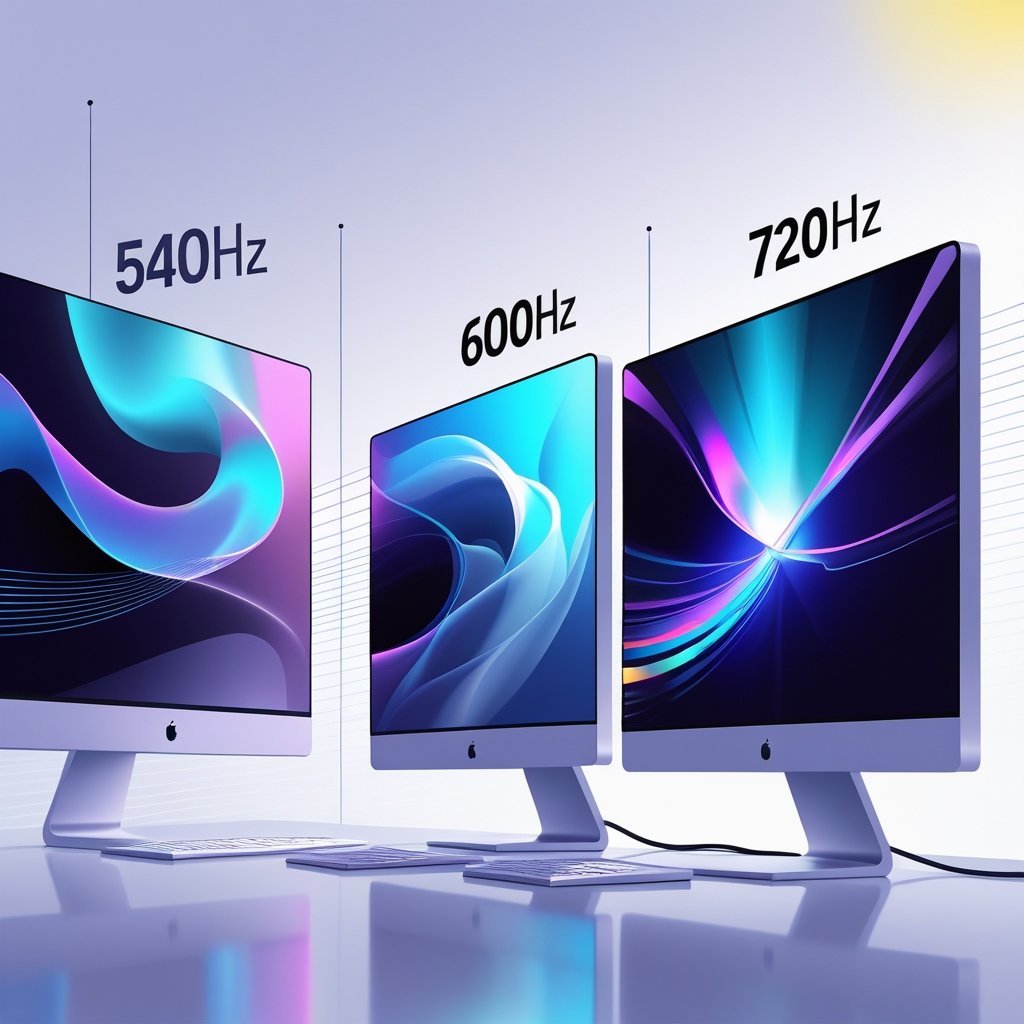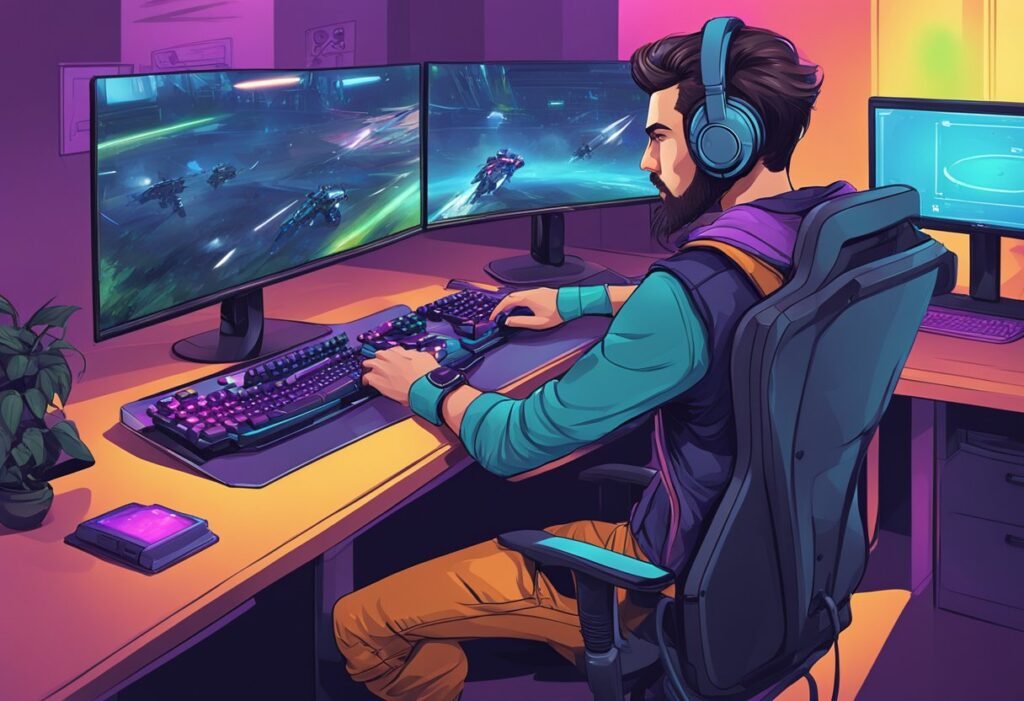WE TESTED 540/600/720HZ, IS IT HYPE OR REAL NEED?
If you’re just a causal gamer looking to play some single player games like Red Dead Redemption 2 you don’t need 720hz or even 540hz, what you need is 200fps and a 4K monitor. However, a competitor gamer, like my self, desires the best visuals and need those high hertz for the best performance. The truth is that while ultra-high refresh rates can feel smoother, the real benefits are limited and depend heavily on the game and the hardware driving it.

Understanding 540Hz, 600Hz, and 720Hz Refresh Rates
The main differences show up in motion clarity, input response, and how well displays like OLED panels from LG Display handle fast-moving visuals.
A higher refresh rate also reduces input latency. For example, a 540Hz refresh rate updates the screen every 1.85 milliseconds, while 720Hz cuts that to about 1.39 milliseconds. That difference is tiny, but in competitive play it can influence reaction timing.
Running 720 frames per second at 1080p requires powerful GPUs and optimized games. For slower-paced titles, the benefits are minimal, but in shooters like Counter-Strike or Overwatch, smoother motion can improve tracking and accuracy.
| Refresh Rate | Frame Time (ms) | Typical Use Case |
|---|---|---|
| 240Hz | 4.16 ms | Standard esports |
| 540Hz | 1.85 ms | High-end esports |
| 720Hz | 1.39 ms | Experimental, niche |
This concise video shows the difference between the everyday 144hz vs a 500hz screen. Check it out
Related Posts
Our Best picks
540hz
The 24.1-inch FHD Esports Gaming Monitor, featuring an overclocked 540Hz refresh rate and the world’s fastest E-TN panel, delivering 50% faster response than traditional TN panels. With NVIDIA G-SYNC ULMB 2 for unmatched motion clarity, NVIDIA Reflex Analyzer for system latency tracking, and robust connectivity including DisplayPort 1.4 DSC, dual HDMI, and USB hub, this monitor is built for pro-level gaming performance. Compact, adjustable, and tournament-ready – add it to your Amazon cart now and experience the speed that gives you the winning edge!
The ZOWIE Fast TN Esports Gaming Monitor, delivering sharper and clearer visuals than IPS with reduced overshoot for distraction-free focus. Featuring DyAc² motion clarity technology with dual backlight design for unmatched blur reduction, plus 35% improved color for vivid target distinction, this monitor gives you the edge in every match. With automatic color mode adjustment, smoother height adjustability, and pro-level tuning, it’s built for serious competitive gamers – add it to your Amazon cart now and experience esports-grade performance!
600hz
BenQ Zowie XL2586X
This BenQ monitor, ZOWIE XL2586X+ Fast TN Esports Monitor, engineered with DyAc² technology for the best motion clarity in the industry. Its native FHD resolution ensures sharp, clear visuals, while the newly developed Fast TN panel reduces overshoot and improves responsiveness. With 35% enhanced color performance, automatic game mode switching, and pro-grade comfort with smooth height adjustment, this monitor is built for peak competitive performance. Add it to your Amazon cart today and experience esports-level clarity and speed!
ASUS ROG Strix Ace
This 600hz monitor with a 24.1-inch Super TN Esports Monitor, built for professional gamers demanding the fastest performance. With 0.8ms input lag, 0.1ms response time, and ELMB 2 technology for superior blur reduction and 3X brighter visuals, every frame is sharper and smoother. The compact design frees desk space, while ROG Gaming AI and DisplayWidget Center make setup effortless. Packed with pro-level features and bonus 3-month Adobe Creative Cloud, this monitor is the ultimate esports weapon – add it to your Amazon cart today and play with world-class speed and clarity!
The Science Behind 540Hz, 600Hz, and 720Hz Panels
These monitors rely on advanced OLED display technology, often developed by companies like LG Display. OLED’s near-instant 0.03ms pixel response time pairs well with extreme refresh rates, ensuring that each frame appears sharp without ghosting.
The SDC Flash 540-Meta monitor, for example, supports 1440p at 540Hz and 1080p at 720Hz. This dual-mode setup balances resolution and refresh rate depending on performance needs.
One technical limitation is bandwidth. DisplayPort 1.4 cannot fully handle 720Hz at high resolutions, which is why many of these panels downscale to 1080p in their fastest modes. Upcoming DisplayPort 2.1 standards will make higher refresh rates more practical.
These panels also push brightness and HDR performance. Some OLED monitors reach up to 1500 nits in HDR, which helps maintain clarity even at extreme speeds. While still early in adoption, 540Hz, 600Hz, and 720Hz panels show how display engineering is stretching beyond what most players thought possible.
Hardware Requirements and Connectivity
GPU and System Demands for Ultra-High Refresh Rates
To drive 540Hz, 600Hz or even 720Hz, the graphics card must push hundreds of frames per second at stable quality. Even high-end GPUs like the NVIDIA RTX 5090 or NVIDIA RTX 5080 struggle to sustain frame rates above 300–400 fps in many modern titles.
Competitive shooters such as CS or Valorant can approach these numbers on powerful rigs. But demanding open-world or ray-traced games rarely reach beyond 150–200 fps at QHD, which makes extreme refresh rates less noticeable.
System memory and CPU also play a role. Fast DDR5 RAM and a CPU with strong single-core performance help reduce bottlenecks. Without this balance, the GPU cannot deliver frames quickly enough to match the display’s refresh potential.
In practice, only esports-focused setups can fully benefit from 540 to 720Hz panels. For most players, frame rate ceilings in real-world games limit the value of pushing beyond 240–360Hz.
HDMI 2.1 and DisplayPort 1.4: Bandwidth and Compatibility
The choice of connection standard is critical. HDMI 2.1 supports up to 48Gbps, which is enough for 4K at 120Hz or QHD at higher refresh rates. However, it struggles with extreme modes like 720Hz unless compression is used.
DisplayPort 1.4 offers 32.4Gbps of bandwidth. This is lower than HDMI 2.1, but it can handle high refresh rates at 1080p or QHD when paired with Display Stream Compression.
Upcoming DisplayPort 2.1 standards will increase bandwidth to 80Gbps or more, making them better suited for future 720Hz panels. Until then, users must rely on optimized settings and compression to avoid signal limitations.
Compatibility also matters. Not all GPUs or monitors enable full bandwidth on every port. Using certified cables and checking supported modes in the GPU driver ensures stable performance.
The Role of Display Stream Compression (DSC)
Display Stream Compression (DSC) is essential when pushing refresh rates beyond the raw limits of HDMI 2.1 or DisplayPort 1.4. It reduces data requirements while aiming to preserve image quality.
DSC is visually lossless in most cases. This means text sharpness, color accuracy, and detail remain nearly identical to uncompressed output. For gaming, the difference is almost impossible to notice in real time.
At 720Hz, DSC allows a panel to accept data that would otherwise exceed port capacity. Without it, even the fastest standards cannot sustain such refresh rates at usable resolutions.
We should note that DSC requires support on both the GPU and the monitor. Most modern GPUs include it, but compatibility checks are still important before investing in ultra-high refresh hardware.
By using DSC, manufacturers can deliver headline specs like 720Hz OLED panels without waiting for newer port standards to become mainstream. This makes compression a key enabler of today’s extreme refresh displays.

